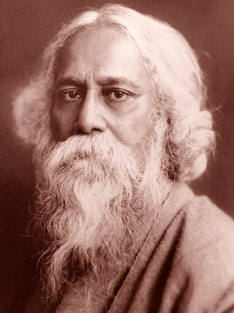
The proponent of Bengal renaissance, Rabindranath Tagore was a polymath who has contributed profusely towards Bengali literature, music and Indian Modernist art. He grew up in a rich and culturally prominent family whose members displayed varied interests in literature, music, philosophy, mathematics and art that became an asset for his artistic wisdom. He was not just an eminent poet but excelled as an actor, playwright, painter, musician, novelist, humanist, philosopher, cultural reformer, educationist and a critic. Youngest amongst the fourteen surviving children of Debendranath Tagore and Sarada Devi, Rabindranath’s poetic piety began at the age of eight and culminated when he took his last breath on 7th August 1941. His love for poetry gained him the Nobel Prize in literature in 1913 for his collection of poems, Gitanjali. As part of his humanitarian work, in 1901 he laid the foundation of an experimental school in Shantiniketan that initiated his ‘Upanishadic ideals of education’ extending it into a world university called Vishva Bharti. He wrote extensively about his views and opinions on modern civilization, ‘jingoistic-chauvinistic’ nationalism, Swadeshi movement, British Raj and so on. Every year he is remembered through many events that pay tribute to him not only in India but around the world. Here are some useful links for more information about his life and works: 1. Carter, Albert Howard. “Rabindranath Tagore.” Books Abroad, vol. 41, no. 1, 1967, pp. 36–37. http://jstor.org/stable/40121302 2. Hsi-Lin, Ting. “Salute Rabindranath Tagore, The Great Poet of India.” Indian Literature, vol. 4, no. 1/2, 1960, pp. 65–67. http://jstor.org/stable/23329355 3. Koffler, Sandy. “Rabindranath Tagore: A Universal Voice.” The UNESCO Courier, no. 12, 1961. http://unesdoc.unesco.org/images/0006/000643/064331eo.pdf 4. Gupta, Uma Das. “In Pursuit of a Different Freedom: Tagore's World University at Santiniketan.” India International Centre Quarterly, vol. 29, no. 3/4, 2002, pp. 25–38. http://jstor.org/stable/23005814 5. DHAR, BANSHI. “The Humanism of Rabindranath Tagore.” Indian Literature, vol. 16, no. 1/2, 1973, pp. 147–152. http://jstor.org/stable/24157437 6. Rao, P. Raja. “Rabindranath Tagore: A Brief-Biography and Contributions to English Literature.” Wordpress. https://rajaraop.files.wordpress.com/2012/04/rabindranath-tagore.pdf 7. Shahane, V. A. “Rabindranath Tagore: A Study in Romanticism.” Studies in Romanticism, vol. 3, no. 1, 1963, pp. 53–64. http://jstor.org/stable/25599602 8. Choudhurani, Indira Devi. “Songs of Rabindranath Tagore.” Indian Literature, vol. 4, no. 1/2, 1960, pp. 22–26. http://jstor.org/stable/23329349 9. Roy, Koushik. “Rabindranath Tagore: Literary Giant with Scientific Bent.” NISCAIR Online Periodicals Repository, vol. 47(9), 2010, pp. 36-39. http://nopr.niscair.res.in/bitstream/123456789/10199/1/SR%2047%289%29%2036-39.pdf 10. SEN, PARITOSH. “Pandora's Box: The Original Art of Rabindranath Tagore.” India International Centre Quarterly, vol. 17, no. 3/4, 1990, pp. 270–280. http://jstor.org/stable/23002468 11. Nehru, Jawaharlal. “Three Years From Now.” Indian Literature, vol. 1, no. 2, 1958, pp. 4–5. http://jstor.org/stable/23329284 12. Quayum, Mohammad. “Rabindranath Tagore: A Biographical Essay.” Researchgate, 2010. https://researchgate.net/publication/282136147_Rabindranath_Tagore_A_Biographical_Essay 13. Urquhart, W. S. “The Philosophical Inheritance of Rabindranath Tagore.” International Journal of Ethics, vol. 26, no. 3, 1916, pp. 398–413. http://jstor.org/stable/2377053 14. Somjee, A. H. “THE POLITICAL PHILOSOPHY OF RABINDRANATH TAGORE.” The Indian Journal of Political Science, vol. 22, no. 1/2, 1961, pp. 134–143. http://jstor.org/stable/41853875 15. Basu, Mita. “Rabindranath Tagore”. Shodhganga, Ch. 8, pp. 290-348. http://shodhganga.inflibnet.ac.in/bitstream/10603/72195/12/12_chapter%209.pdf 16. Archer, W. G. “Poet's Pictures : The Drawings of Rabindranath Tagore.” Indian Literature, vol. 4, no. 1/2, 1960, pp. 182–185. http://jstor.org/stable/23329372 17. Pound, Ezra. “Tagore's Poems.” Poetry, vol. 1, no. 3, 1912, pp. 92–94. http://jstor.org/stable/20569670 18. Glaysher, Frederick. “The Poet’s Religion of Rabindranath Tagore.” Rupkatha, Vol. 3, No. 4, 2011. http://rupkatha.com/V3/n4/02_Religion_Rabindranath_Tagore.pdf 19. Archer, W. G. “The Paintings of Tagore.” East and West, vol. 12, no. 2/3, 1961, pp. 147–151. http://jstor.org/stable/29754395 20. NANDAKUMAR, PREMA. “TAGORE AND BHARATI.” Indian Literature, vol. 12, no. 1, 1969, pp. 31–39. http://jstor.org/stable/23329115 21. Tagore, Rabindranath. “My School.” DPSC Birbhum. http://birbhum.gov.in/DPSC/reference/MySchool.pdf 22. Dimock, Edward C. “Rabindranath Tagore--‘The Greatest of the Bauls of Bengal.’” 23. “What to Read in Tagore?” Indian Literature, vol. 29, no. 3 (113), 1986, pp. 61–64. http://jstor.org/stable/23336043 24. Sen, Nabaneeta. “The ‘Foreign Reincarnation’ of Rabindranath Tagore.” The Journal of Asian Studies, vol. 25, no. 2, 1966, pp. 275–286. http://jstor.org/stable/2051328 25. Jha, Narmadeshwar. “Rabindranath Tagore” UNESCO: International Bureau of Education, vol. XXIV, no. 3/4, 1994, pp. 603-19. https://slideshare.net/dokka/rabindranath-tagore-11816232 26. CATLIN, GEORGE E. GORDON. “RABINDRANATH TAGORE.” Journal of the Royal Society of Arts, vol. 109, no. 5060, 1961, pp. 613–628. http://jstor.org/stable/41369071 27. Tagore, Rabindranath. “Gitanjali.” Internet Sacred Text Archive. 1992.
28. Mukherjee, Sisir Kumar. “SOURCES FOR INDIAN MUSIC: The Songs of Rabindranath Tagore.” Fontes Artis Musicae, vol. 44, no. 3, 1997, pp. 281–289. http://jstor.org/stable/23508496 29. Sen, Amartya. “Tagore and His India.” Nobleprize.org. 2001. https://nobelprize.org/nobel_prizes/literature/laureates/1913/tagore- article.html 30. Joobin Bekhrad, When Rabindranath Tagore revisited an old connection in Iran, Scroll.in https://scroll.in/article/819842/when-rabindranath-tagore-revisited-an-old-connection-in-iran 31. Afshin Marashi, Imagining Hāfez: Rabindranath Tagore in Iran, 1932, Journal of Persianate Studies, Volume 3, Issue 1, pages 46–77. http://booksandjournals.brillonline.com/content/journals/10.1163/187471610x505951 32. Mahfuz Ul Hasib Chowdhury, Bengal's bridgework with Persia through Tagore, Daily Asian Age, 21 May 2017. http://dailyasianage.com/news/62526/bengals-bridgework-with-persia-through-tagore This list is in progress. Please let us know if you know of some good archive on the Internet which concerns us and we may have missed. Please report if you find any dead links. |
 Rabindranath Tagore
Rabindranath Tagore